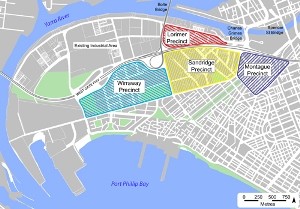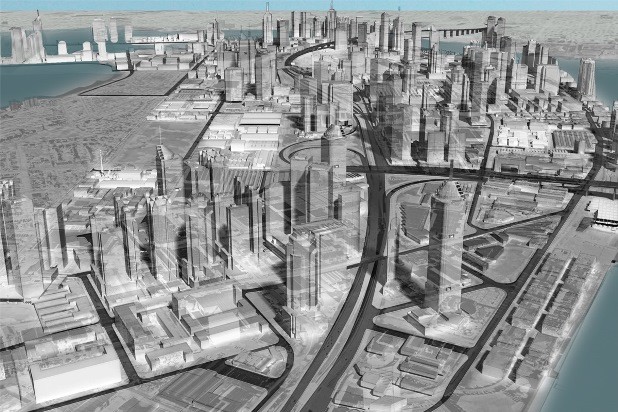Melbourne is set to develop a new inner-city suburb that the government says will more than double the size of the central city.
Victoria’s Planning Minister Matthew Guy has approved the final master plan for the development of Fishermans Bend. The new Strategic Framework Plan (SFP) will guide the development of a 250 hectare precinct on the doorstep to Melbourne’s CBD.
Guy called it “Australia’s most significant urban renewal project", saying it provides a long term framework for a precinct that will transform Melbourne by linking the CBD to Port Phillip Bay, supporting 40,000 new jobs and providing homes for at least 80,000 residents.
He said construction alone will deliver billions of dollars in economic benefits to Victoria over the next 40 years.
“The precinct will ultimately double the size of our central city, boosting Melbourne’s productivity by extending the capital city’s commercial appeal and skilled workforce," Guy said.
 Fishermans Bend Urban Renewal Area (click for full sized PDF)
Fishermans Bend Urban Renewal Area (click for full sized PDF)
“Fishermans Bend will be served by excellent transport links, serviced by cycling and pedestrian links, roads, trams and rail via the new Melbourne Rail Link. The new rail link will include a new underground station at Montague precinct, which will provide a high volume of peak services early in the development of the area.”
He added that planning has been informed by extensive community consultation and collaboration with the City of Melbourne and City of Port Phillip.
However, not all have been in agreement. In 2013, responding to “the drip feeding of information regarding the development”, the RMIT University Master of Architecture Program held a series of urban scale research studios “to contribute ideas for this new city through design strategies, not masterplans”.

The studios were led by architect Simon Whibley, who posted the research on his website.
 Images from RMIT Research Studios. Source: Simon Whibley Architecture
Images from RMIT Research Studios. Source: Simon Whibley Architecture
Guy said the development of Fishermans Bend was a key initiative of Plan Melbourne, which sets out the management of Victoria’s growth to 2050.
“Melbourne is expected to have a population of 7.7 million by 2051, rapidly growing from its current population of 4.3 million. Accommodating this growth requires careful long term planning and development in strategically important locations,” Guy said.
“The Victorian Coalition Government’s metropolitan planning strategy, Plan Melbourne, identified Fishermans Bend as a key growth area for Melbourne and a strategically important development opportunity. Planning for the precinct identifies a mix of housing options, commercial opportunities and attractive public spaces, facilities and key services.
Sustainability
The Green Building Council of Australia (GBCA) has called on the Victorian Government to ensure the project meets best practice benchmarks for sustainability, and is lobbying for the application of its Green Star rating.
“Minister Guy has called Fishermans Bend ‘Australia’s most significant urban renewal project’ – one which is expected to create investment, jobs and commercial opportunities,” said GBCA Chief Operating Officer, Robin Mellon.
“How we plan, design and build a precinct of this size – one that will double the size of central Melbourne – will have an enormous impact on more than the Victorian economy. It will also have an enormous impact on the environment and on people’s lives, health and wellbeing,” Mellon explains.
“Other significant urban renewal projects around Australia such as Barangaroo South and the Parramatta Square in Sydney, Caloundra South and Ecco Ripley in Queensland, Bowden and Tonsley in Adelaide, and Alkimos Beach and Waterbank in Perth, not to mention the University of Melbourne's Parkland Campus in Melbourne, are applying the Green Star – Communities rating tool to ensure they meet best practice benchmarks for governance, design, environment, liveability, financial prosperity and innovation.
“Meeting these benchmarks does not need to cost more, but will deliver massive long-term benefits. How will the people of Victoria know that their community – one that will one day be home to 80,000 residents – meets Australian benchmarks for sustainability, leadership, transparency and efficiency?”
Design Guidelines
The Fishermans Bend SFP has been adopted as an amendment to the Melbourne and Port Phillip planning schemes. This plan also includes detailed design guidelines.
Guy said a Development Contributions Plan for the precinct was being prepared, with Section 173 agreements to be used as an interim measure for existing permit applications.
“Development of Fishermans Bend is a 40-year project but I have approved a limited number of permit applications that will allow some construction to start in the near future. Developers will be required to make financial contributions towards new infrastructure as part of their permit conditions,” he said.
Guy said permit applications for land within the precinct would be assessed in the context of the Fishermans Bend SFP. The Metropolitan Planning Authority, which prepared the plan, will become the Responsible Authority for the precinct.

